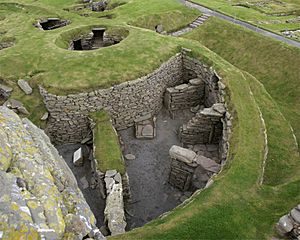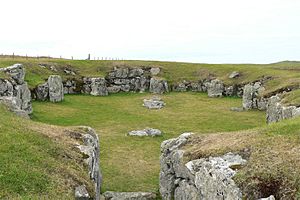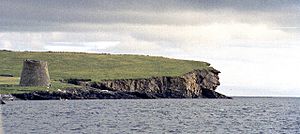Prehistoric Shetland facts for kids

Prehistoric Shetland is all about the time before people started writing down history on the Shetland islands in Scotland. This period covers when humans first arrived and lived there, right up until around the year 900 AD. That's when the Vikings came and started keeping written records.
Because Shetland had very few trees, early people built many things using stone. This means there are over 5,000 amazing old sites to explore today, showing us how people lived long ago!
Contents
Early People in Shetland
Mesolithic and Neolithic Periods
The very first signs of people living in Shetland come from a place called West Voe. Here, archaeologists found a midden, which is like an ancient rubbish dump. It shows that people were here between 4320 and 4030 BC. These were Mesolithic people, also known as Middle Stone Age people.
Later, during the Neolithic or New Stone Age, more people arrived. At a site called Scord of Brouster, archaeologists found evidence of farming from around 3400 BC. This site has old stone houses and fields. They even found the oldest hoe blades in Scotland there! People in Shetland at this time also made special stone tools called "Shetland knives" from a type of rock found in Northmavine.
People in Neolithic Shetland built unique tombs called Heel-shaped cairns. These are stone burial mounds shaped like the heel of a shoe. A very large one can be seen on the island of Vementry.
Another interesting site is Stanydale Temple near Bixter. It's a large stone ruin with an oval room. Around it, you can find remains of houses and walls from the same time. There are also many standing stones from the Neolithic period, like those on Whalsay and Unst. On Fetlar, there's a ring of stones called Hjaltadans.
A huge stone wall, called Funzie Girt, stretched for 4 kilometers (about 2.5 miles) across the island of Fetlar. Building such a big wall would have needed a lot of people working together. This suggests that many people lived in Shetland during the Neolithic period, perhaps as many as 10,000!
Bronze Age and Early Iron Age Settlements
The important site of Jarlshof shows that people lived there for thousands of years. While some pottery from the Neolithic period has been found, the main settlement dates from the Bronze Age. At Jarlshof, you can see the remains of an ancient smithy (a place where metal was worked), several wheelhouses (round stone houses with spokes like a wheel), and a later broch. People continued to live at Jarlshof right up until Viking times.
During the Iron Age, many tall, round stone towers called brochs were built. The Broch of Mousa is the best-preserved example of these amazing towers in Scotland. Other important broch ruins can be found at Clickimin, Culswick, Old Scatness, and West Burrafirth. We don't know for sure why these brochs were built, but they are very impressive.
In 2011, a group of sites including the Broch of Mousa, Old Scatness, and Jarlshof were added to the UK's list of possible World Heritage Sites. This group is called "The Crucible of Iron Age Shetland".
Ancient Travelers and Shetland
Some ancient Roman writers, like Pomponius Mela (in AD 43) and Pliny the Elder (in AD 77), wrote about seven islands they called Haemodae or Acmodae. People think they were talking about Shetland.
The name "Thule" was first mentioned by a Greek explorer named Pytheas, who visited Britain between 322 and 285 BC. However, he described Thule as being very far north, near a frozen sea, which sounds more like Iceland than Shetland.
Later, in AD 98, the Roman historian Tacitus wrote that the Roman fleet saw "Thule" during a trip that included Orkney. Some historians believe Tacitus was referring to Shetland. However, there is no proof that Roman soldiers ever directly visited Shetland. The Romans mostly stayed in other parts of Scotland for short periods.
Later Iron Age and the Picts

The people living in the Northern Isles (Orkney and Shetland) during the later Iron Age were probably Picts. The Picts were an ancient people who lived in eastern and northern Scotland. We don't have many written records from this time. However, historians believe that the Pictish people of Shetland and Orkney would have seen their king, Bridei I, as a distant ruler.
A very special discovery was made in 1958 on St Ninian's Isle. A local schoolboy, Douglas Coutts, found the St Ninian's Isle Treasure while helping archaeologists. This treasure includes beautiful silver bowls, jewelry, and other items. They are thought to be from around AD 800. Experts say it's the best collection of Scottish silver metalwork from that time. The brooches (pins) in the treasure show typical Pictish designs, with animal heads and geometric shapes.
The Viking Era Begins
In the late 700s and 800s, Norsemen (Vikings) from Norway started to settle in Shetland. We don't know exactly what happened to the people who lived there before the Vikings arrived.
According to an old story called the Orkneyinga Saga, the Vikings used Shetland as a base to launch pirate attacks against Norway and the coasts of mainland Scotland. Because of this, the Norwegian king, Harald Fairhair, took control of Orkney and Shetland in 875. He then gave them to Rognvald Eysteinsson as an earldom. Some historians think this story might not be completely true, but it shows how important the Vikings became.
As the Viking era continued, Shetland moved from its prehistoric period into the time of written history.



